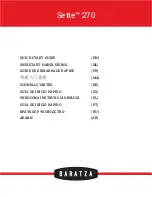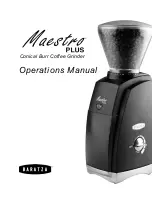
9
English
n
As soon as the device reaches the required temperature, the "on/off" and "steam pre-heating" lights stop
flashing. Turn the knob to the “steam” position
(fig. 13)
. The milk is transferred from the container to the cup.
n
Once the milk has been frothed, turn the knob to the “0” position
(fig.15).
The appliance will now
automatically cool itself by launching a number of intermittent pumping cycles. Once this automatic
operation is complete, you can make a coffee.
n
To clean the auto-cappuccino device, please repeat the milk foaming procedure by replacing the 100ml
of milk with 100ml water.
n
For thorough cleaning of the cappuccino accessory, see the paragraph "Cleaning and Maintenance".
n
IMPORTANT: Your espresso machine accessories are not dishwasher-safe. Do not wash the spoon,
the drip tray, the filter holder and the water tank in the dishwasher.
CLEANING OF THE MACHINE
n
Unplug the power supply before cleaning and let the appliance cool down.
n
Clean the outside of the appliance from time to time with a damp cloth. After use, the water tank must
be emptied.
n
Rinse inside the tank regularly.
n
When a thin white layer starts to form in the tank, carry out a descaling operation (see paragraph 9
"DESCALING").
CLEANING OF THE DRIP TRAY
The drip tray must be emptied after each time the appliance is used. Lift up slightly and remove it from the
appliance.
If multiple espressos are prepared one after the other, it should be emptied from time to time (every 7 to
8 espressos approximately)
(fig.19 and 20)
. The presence of water is normal and is not the sign of a leak.
If necessary, clean the drip tray and its grid with water and a little gentle washing-up liquid, rinse and dry.
When reassembling the components, make sure everything is in the right place.
CLEANING OF THE BREWING HEAD AND FILTER HOLDER
n
They must be cleaned after each use. Simply wipe a damp cloth over the percolation head
(fig. 21)
and clean the filter holder under running water and use a small amount of gentle washing-up liquid.
n
Do not use alcohol or solvent-based cleaning products.
n
For best results, you can activate the "EJECT" button several times during rinsing. We recommend that
you shake the filter holder thoroughly in order to remove all the water.
n
Rinse and dry.
n
When not using your espresso coffee maker, do not leave the filter holder fitted in the appliance, in
order to avoid wear to the seal
For more thorough cleaning, the filter holder can be dismantled:
n
You can remove the black plastic part where the coffee outlets and the "EJECT" button are to be found:
turn it to the left and pull sharply
(fig. 22)
.
n
Clean the various components under running water and a little gentle washing-up liquid.
n
Rinse and dry.
n
Replace the black plastic part in the metal holder, turn it to the right until the two arrows on each
component line up.
If the percolation head is heavily clogged up, unscrew the grid using a screw-driver, clean it and refit it,
pressing down firmly
(fig.23)
.
7. CLEANING AND MAINTENANCE
KR_XP52_AUTOMATIC_NAFTA_NC00026257-01 18/11/11 14:11 Page9














































